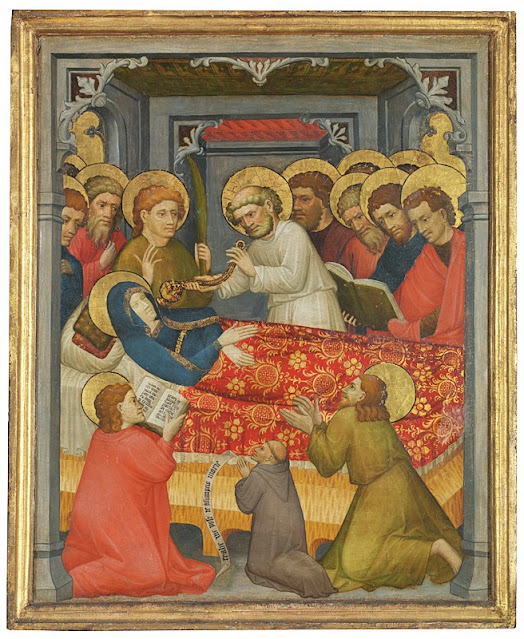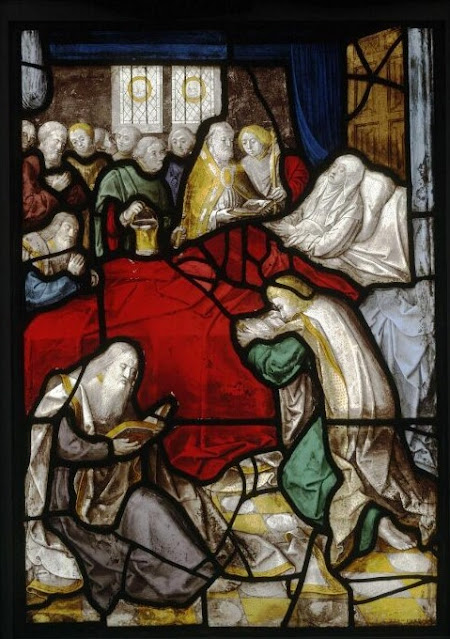The Feast of the Assumption of the Virgin Mary is one of the major feasts of the Church year. The bodily Assumption of Mary into heaven upon her death has for centuries been celebrated in both the Eastern (Greek-speaking) and Western (Latin-speaking, now vernacular) churches.
Although it was not until 1950 that Pope Pius XII issued the Papal Bull “Munificentisisimus Deus”, 1 which declared that the Assumption was truly an article of faith, its history goes far, far back in time. It has been celebrated as a liturgical feast since shortly after the fourth century recognition of Christianity.
The belief in Mary’s bodily translation into heaven comes from several sources:
Stories of more or less believability have grown up around the death of Mary, also called the Dormition (falling asleep) or (in Greek) the Koimesis of the Virgin and all of these have been translated into visual representations over the centuries. In this essay I will discuss the stories of some of the supposed events that preceded the Assumption itself. In another essay I describe some of the iconography related to the actual death, mourning and burial of the Blessed Virgin, while a separate essay deals with the images of the Assumption itself. Further in two additional essays I will describe the final episodes, the Coronation of Mary as Queen of Heaven and the images of Mary as Queen. The sources of all these stories were collected together by Jacobus de Voragine in the Golden Legend,4 but they pre-existed his compilation and were known in both East and West.
The Feast of the Assumption of the Virgin Mary is one of the major feasts of the Church year. The bodily Assumption of Mary into heaven upon her death has for centuries been celebrated in both the Eastern (Greek-speaking) and Western (Latin-speaking, now vernacular) churches.
Although it was not until 1950 that Pope Pius XII issued the Papal Bull “Munificentisisimus Deus”, 1 which declared that the Assumption was truly an article of faith, its history goes far, far back in time. It has been celebrated as a liturgical feast since shortly after the fourth century recognition of Christianity.
The belief in Mary’s bodily translation into heaven comes from several sources:
- Theological reflection on Mary’s status as mother of Jesus, expressed as the belief (confirmed by the First Council of Ephesus in 431, the third ecumenical council 2) that, as the mother of the Christ she is also the Mother of God (in Greek Theotokos, in Latin Mater Dei) and, therefore, received a special dispensation both from Original Sin and from the physical effects of Death.
- Further theological reflection that her status makes her the first human to experience the glorious state of those saved by Christ to which all who believe in Him will come at the end of time. As the Catechism of the Catholic Church states: “The Assumption of the Blessed Virgin is a singular participation in her Son's Resurrection and an anticipation of the resurrection of other Christians.”3
- The early appearance of liturgical celebrations of her death and assumption into heaven, as noted above, and the prayers that have been passed down from those liturgies.
- The curious fact that in eras (such as the Middle Ages) intensely interested in the acquisition of relics of the saints, often resulting in unseemly events of theft and downright faking, no physical relics of Mary’s body parts seem to be located anywhere. This is especially interesting in view of the fact that many locations claim bits of the bodies of her contemporaries, such as St. John the Baptist or the Apostles. It is true that some places claim objects associated with the Virgin Mary, but this only makes the missing body more interesting. For, if the effect of the preservation of a garment believed to be her tunic from a fire in 1194 could have stimulated the amazing building activity of the Cathedral of Chartres 4 it is rather astonishing that no place claims her arm or hand or head.
Stories of more or less believability have grown up around the death of Mary, also called the Dormition (falling asleep) or (in Greek) the Koimesis of the Virgin and all of these have been translated into visual representations over the centuries. In this essay I will discuss the stories of some of the supposed events that preceded the Assumption itself. In another essay I describe some of the iconography related to the actual death, mourning and burial of the Blessed Virgin, while a separate essay deals with the images of the Assumption itself. Further in two additional essays I will describe the final episodes, the Coronation of Mary as Queen of Heaven and the images of Mary as Queen. The sources of all these stories were collected together by Jacobus de Voragine in the Golden Legend,4 but they pre-existed his compilation and were known in both East and West.
The Annunciation of the Death of the Virgin.
,%20c.%201050_Paris,%20BNF_MS%20Latin%2011550,%20fol.%20275v.jpg) |
| Master Ingelard, The Annunciation of the Death of Mary From a Hymnarium French (Paris, Saint-Germain-des-Pres), c. 1050 Paris, Bibliotheque nationale de France MS Latin 11550, fol. 275v |
 |
Duccio, The Annunciation of the Death of the Virgin Italian, c. 1308-1311 Siena, Museo dell'Opera del Duomo |
,%20c.%201316-1331+New%20York,%20Morgan_MS%20G%2050,fol.160r.jpg) |
The Annunciation of the Death of the Virgin From the De Lisle Hours England (possibly York), c. 1316-1331 New York, Pierpont Morgan Library MS G 50, fol.160r |
,%20c.%201355-1365_New%20York,%20Pierpont_MS%20M769,%20fol.%20.299r.jpg) |
| The Annunciation of the Death of the Virgin From a Weltchronik German (Regensburg), c. 1355-1365 New York, Pierpont Morgan Library MS M 769, fol. 299r |
,%20c.1400-1410_LA,%20Getty_MS%2033,%20fol.%20304r.jpg) |
| Brother Philipp, The Annunciation of the Death of the Virgin From a Weltchronik German (Regensburg), c.1400-1410 Los Angeles, J. Paul Getty Museum MS 33, fol. 304r |
,%20c.%201430-1435_New%20York,%20Pierpont_MS%20M359,%20fol.100r.jpg) |
| Bedford Master and Workshop, The Annunciation of the Death of the Virgin From a Book of Hours French (Paris), c. 1430-1435 New York, Pierpont Morgan Library MS M 359, fol.100r |
,%201473_New%20York,%20Pierpont_MS%20M677,%20fol.%20158v.jpg) |
| Jean Colombe and Workshop, The Annunciation of the Death of the Virgin From the Hours of Anne of France French (Bourges), 1473 New York, Pierpont Morgan Library MS M 677, fol. 158v |
While this is largely a medieval subject it does appear in some later art, as for instance in this painting from the Dutch golden age.
 |
| Samuel van Hoogstraten, The Annunciation of the Death of the Virgin Dutch, c. 1670 New York, Metropolitan Museum of Art |
There is a beautiful choral anthem that describes Mary’s reaction composed recently by Sir John Tavener (born 1944), a convert to Orthodox Christianity, to which I’m adding a You Tube link.
The gathering of the Apostles
In this portion of the story all the living apostles were miraculously brought by angels from all the places on earth to which their preaching had taken them so that they might be present for her death. This is also not too frequently depicted as a separate image. |
The Apostles Gathered at the Virgin's Deathbed English, 15th Century London, Victoria and Albert Museum |
 |
| Hans Suess von Kulmbach, The Apostles Gathered at the Virgin's Deathbed German, First Quarter of 15th Century Munich, Bayerische Staatsgemäldesammlungen, Alte Pinakothek |
 |
Austrian School Painter, The Apostles Gathered at the Virgin's Deathbed Austrian, 15th Century Paris, Musée du Louvre |
 |
| The Apostles Gathered at the Virgin's Deathbed Tyrolese, c. 1420-1430 London, National Gallery |
 |
Niccolo Pisano, The Apostles Gathered at the Deathbed of the Virgin Italian, c. 1485-1500 Paris, Musée du Louvre |
 |
Hans Klocker, Apostles Gathered Around Mary as She Waits for Death Austrian, c. 1481-1495 Chicago, Art Institute |
 |
| Workshop of Tilman Heysacker, The Apostles Gathered at Mary's Deathbed German, Late 15th Century New York, Metropolitan Museum of Art, The Cloisters Collection |
,%20c.%201500_London,%20British%20Library_MS%20Yates%20Thompson%205,%20fol.%2060r%20A.jpg) |
| Jean Poyer, The Apostles Praying at the Virgin's Deathbed From a Book of Hours French (Tours), c. 1500 London, British Library MS Yates Thompson 5, fol. 60r |
 |
| Master of the Amsterdam Death of the Virgin, The Apostles Praying at the Virgin's Deathbed Dutch, c. 1500 Amsterdam, Rijksmuseum |
.jpg) |
Master of the Oberschoenenfelder Altar, The Apostles Gathered at the Virgin's Deathbed German, c. 1500 Munich, Bayerische Staatsgemäldegalerie , Alte Pinakothek |
 |
Hans Holbein the Elder, The Apostles Gathered Around Mary as She Waits for Death German, c. 1502 Munich, Bayerische Staatsgemäldesammlungen, Alte Pinakothek |
 |
Hans Schaeufelein, The Apostles Gathered in Prayer at Mary's Deathbed From the Christgatner Altar German, c. 1515-1516 Munich, Bayerische Staatsgemäldesammlungen, Alte Pinakothek |
,%20c.%201515-1525_Paris,%20BNF_MS%20NAL%2083,%20fol.%2065R.jpeg) |
| Master of the Ango Hours, The Deathbed of the Virgin with Donor From a Prayer Book French (Rouen), c. 1515-1525 Paris, Bibliotheque nationale de France MS Noubelle acquisition latine 83, fol. 65R |
 |
| The Apostles at the Deathbed of the Virgin Mary Flemish, c. 1520 London, Victoria and Albert Museum |
 |
| The Deathbed of the Virgin with Donor Alexius Funck and His Family Austrian, c. 1521-1522 Vienna, Belvedere Museum |
 |
| Carlo Saraceni, The Apostles Gathered for the Death of the Virgin Italian, c. 1610-1620 Venice, Galleria della Accademia |
| Luca Giordano, The Death of the Virgin Italian, c. 1696 Vienna, Kunsthistorisches Museum, Gemäldegalerie |
 |
Charles de la Fosse, The Apostles Gathered Around Mary as She Waits for Death French, c. 1700 Cherbourg-Octeville, Musée Thomas Henry |
 |
| Cosmas Damian Assam, The Death of the Virgin German, c. 1725-1726 Klaudrae, Benedictine Abby Church of the Assumption |
© M. Duffy, 2011, revised, with additional material 2019. Completely revised 2022
Notes:
1. Pius XII, Munificentissimus Deus: Defining the Dogma of the Assumption, November 1, 1950. The complete text in English is available at http://www.vatican.va/holy_father/pius_xii/apost_constitutions/documents/hf_p-xii_apc_19501101_munificentissimus-deus_en.html
2. For a review of the First Council of Ephesus see, http://www.newadvent.org/cathen/05491a.htm
3. Catechism of the Catholic Church, Second edition, article 966. Available online at http://www.vatican.va/archive/ENG0015/__P2C.HTM
The Golden Legend (Legenda Aurea), Compiled by Jacobus de Voragine, 1275, Englished by William Caxton, 1483, Vol. 4, pp. 110-117. Available online at http://www.fordham.edu/halsall/basis/goldenlegend/GoldenLegend-Volume4.asp#Assumption
1. Pius XII, Munificentissimus Deus: Defining the Dogma of the Assumption, November 1, 1950. The complete text in English is available at http://www.vatican.va/holy_father/pius_xii/apost_constitutions/documents/hf_p-xii_apc_19501101_munificentissimus-deus_en.html
2. For a review of the First Council of Ephesus see, http://www.newadvent.org/cathen/05491a.htm
3. Catechism of the Catholic Church, Second edition, article 966. Available online at http://www.vatican.va/archive/ENG0015/__P2C.HTM
4. Such legendary "events" as the annunciation of the Virgin's impending death, the gathering of the apostles in Jerusalem and the punishment of the sacrilegious men at the funeral come from the compilation of such legends made in the late 13th century known as the
,%20c.1385-c.1399_London,%20British%20Library_MS%20Additonal%2037955A%20(1).jpg)
,%20c.%201450-1460_New%20York,%20Pierpont_MS%20M868,%20fol.%2057v.jpg)
,%20c.%201450-1460_New%20York,%20Pierpont_MS%20M868,%20fol.%2059r.jpg)
,%20c.%201450-1460_New%20York,%20Pierpont_MS%20M868,%20fol.%2060v.jpg)
,%201463_Paris,%20BNF_MS%20Francais%2050,%20fol.%20243r%20(2).jpg)

,%20c.%201480-1490_Paris,%20BNF_MS%20Francais%20245,%20fol.%2043r.jpeg)